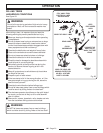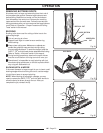
UK - Page 22
3. Cut a notch about one-third the diameter of the trunk in
the side of the tree. Make the notch cuts so they
intersect at right angles to the line of fall. This notch
should be cleaned out to leave a straight line. To keep
the weight of the wood off the saw, always make the
lower cut of the notch before the upper cut. See
Figure 31.
4. Make the back-cut level and horizontal, and at a minimum
of 5 cm (2 in) above the horizontal cut of the notch.
See Figure 31.
NOTE: Never cut through to the notch. Always leave a
band of wood between the notch and back cut approxi-
mately 5 cm (2 in) or one-tenth the diameter of the tree).
This is called the “hinge” or “hinge wood”. It controls the
fall of the tree and prevents slipping, twisting or shoot-
back of the tree off the stump. See Figure 32.
On large diameter trees, stop the back cut before it is
deep enough for the tree to either fall or settle back on
the stump. Then insert soft wooden or plastic wedges
into the cut so they do not touch the chain. Drive
wedges in, little by little, to help jack the tree over. See
Figure 33.
When bucking or felling with a wedge, it may be neces-
sary to remove the SAFE-T-TIP anti-kick-back device to
allow the bar to be drawn through the cut. After you
complete the cut, reinstall the tip immediately.
5. As tree starts to fall, stop the chainsaw and put it down
immediately. Retreat along the cleared path, but watch
the action in case something falls your way.
HINGE
5 cm (2 in.) OR 1/10 DIA
HINGE
BACK CUT
WEDGE
NOTCH -
APPROX. 1/3
DIAMETER OF
TRUNK
BACK CUT
5 cm (2 in.)
Fig. 33
Fig. 32
Fig. 31
OPERATION
WARNING:
Never cut through to the notch when making a back
cut. The hinge controls the fall of the tree: this is the
section of wood between the notch and back cut.
NOTCH


















